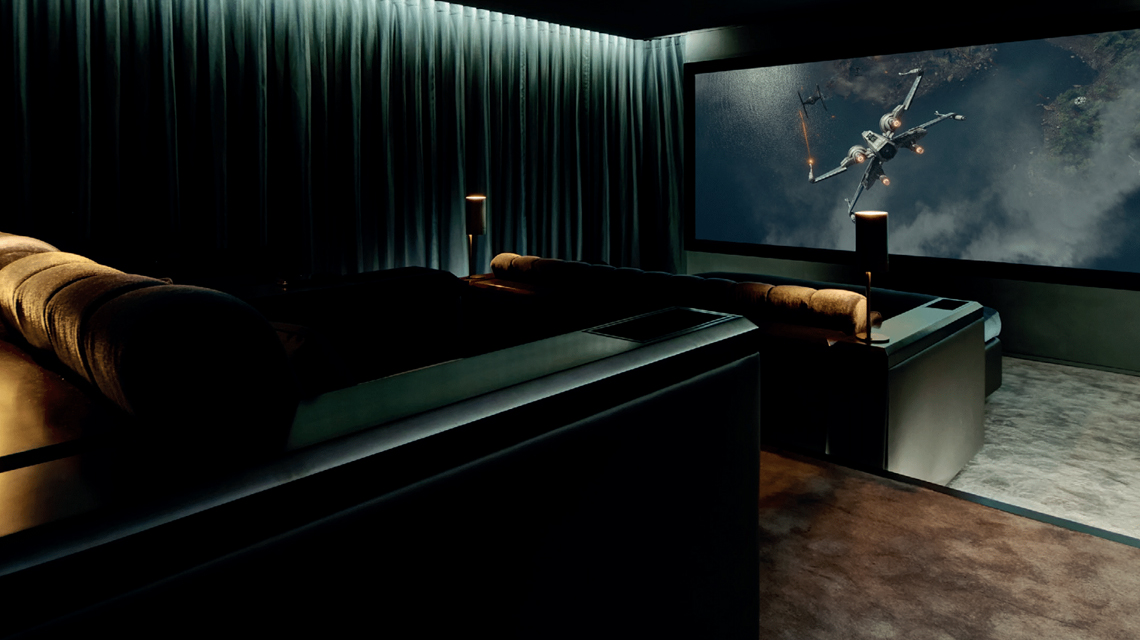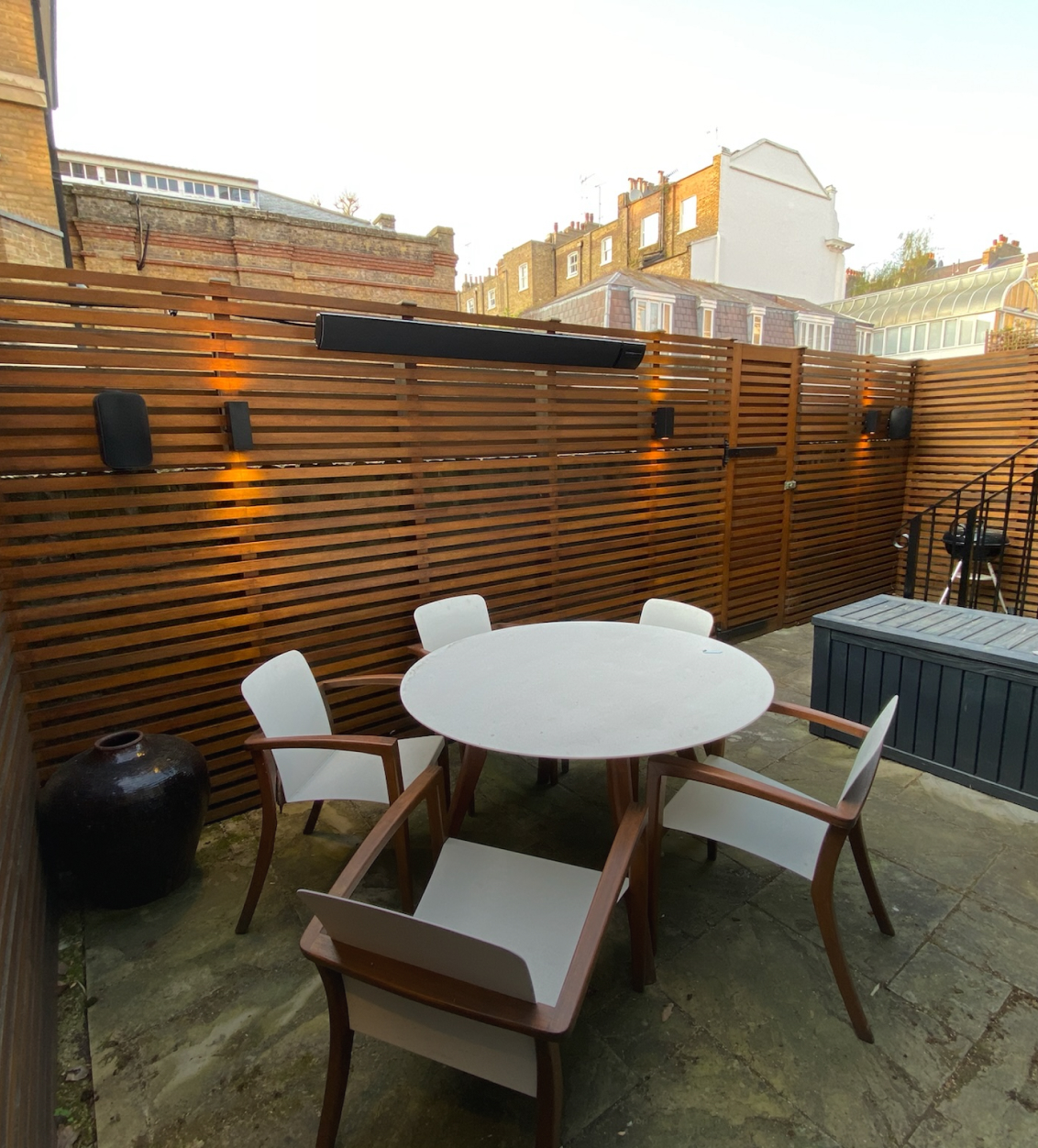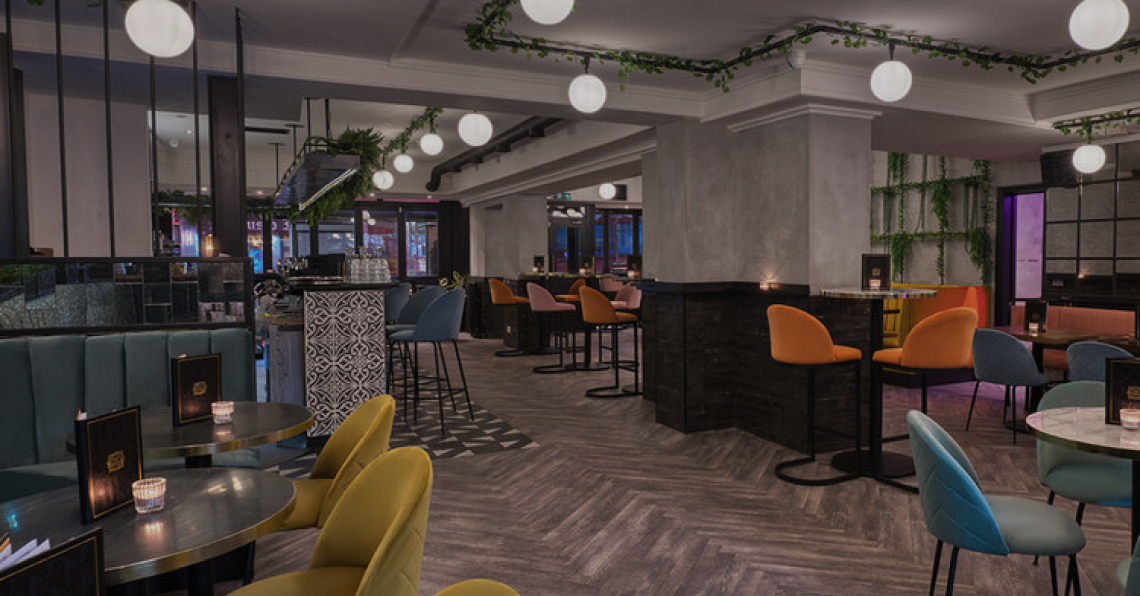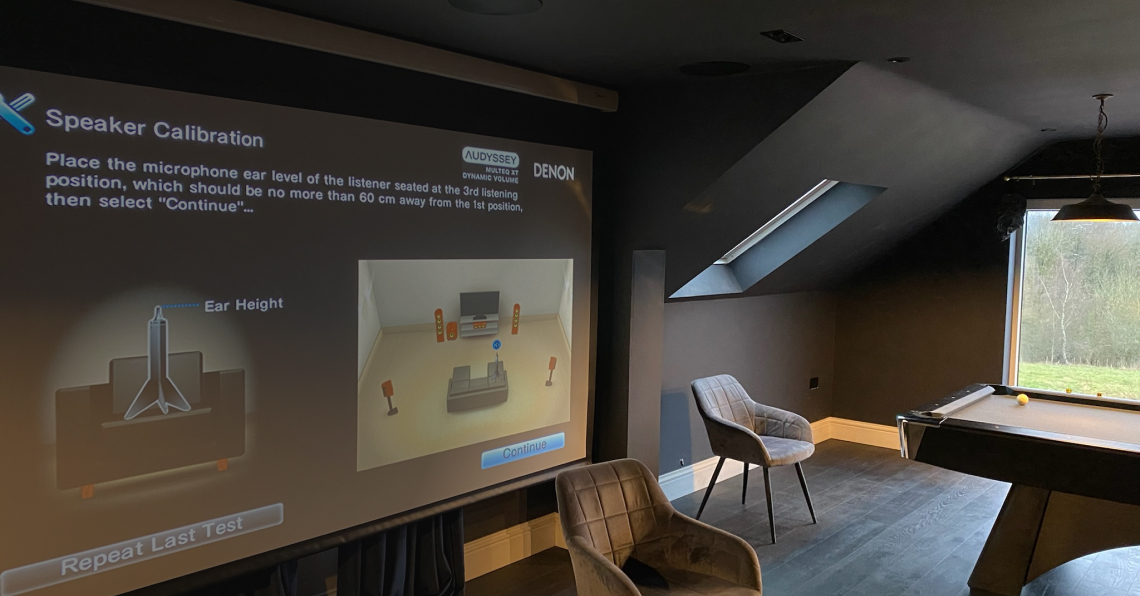How to Create the Ultimate Home Cinema Room
A home cinema room is more than a luxury. It is a dedicated space designed for immersive viewing, personalised comfort and seamless technology.

Quick Steps to Creating a Home Cinema Room
- Assess your space and choose the right location
- Decide between a large TV or projector
- Select a high-quality sound system
- Plan comfortable, optimised seating
- Integrate smart lighting and controls
- Fine-tune acoustics and room layout
- Add finishing touches for ambience

What Is a Home Cinema Room?
A home cinema room is a purpose-built space designed to replicate the audio-visual experience of a commercial cinema. It typically includes a large display (TV or projector), surround sound system, carefully arranged seating and tailored lighting.
More than just a room with a big screen, a true home cinema balances technical performance with user-friendly design. It offers a place to unwind, entertain and enjoy film and television as they were meant to be experienced, immersively and without distraction.
Assessing Your Space
Start by evaluating your home for the most suitable room. A spare bedroom, loft, basement or large outbuilding can all work well. Rectangular rooms are preferred for their acoustic flexibility and ease of layout. Carpeted floors and soft furnishings help reduce echo and manage sound.
Natural light can be a challenge for projector-based setups, so choose a space where blinds or blackout curtains can be fitted if needed. Also consider the room’s position in relation to other living spaces to avoid noise disturbance for other members of the household.
Planning the Layout
Before purchasing any equipment, map out your room’s layout. Decide where the screen will go and work out viewing angles and sightlines from each seat.
Seating should allow everyone in the room to see the screen comfortably without straining their neck or eyes.
Speaker placement also needs early consideration. A 5.1 or 7.1 surround sound system will require specific speaker positions to work effectively. Factor in cable routing or, better still, explore wireless speaker options or fully integrated solutions.
Choosing Your Display: TV or Projector?
Large Screen TV
For many, a high-end television is the most practical choice. Today’s premium TVs offer exceptional image clarity, colour accuracy and dynamic range, even in rooms with moderate ambient light. Choose the largest screen size suitable for your space, maintaining a balance between immersion and comfort. Look for a model with high dynamic range (HDR) and local dimming to deliver richer contrast and deeper blacks. OLED and QLED panels both offer impressive picture quality and are ideal for mixed use, including films, gaming and day-to-day TV.
If you’re looking for something truly statement-worthy, large-format options like a C SEED TV can take things to the next level. With screens up to 165 inches, precision engineering and a disappearing design that folds into the floor when not in use, it offers a striking blend of art and technology.
Projector Options
If you are aiming for a truly cinematic scale, a projector may be the better route. Capable of screen sizes beyond 130 inches, projectors can provide a sense of scale that TVs struggle to match. Ultra-short throw projectors are especially useful for smaller rooms, as they sit close to the wall and require minimal ceiling mounting or cable rerouting. For the best results, pair your projector with an ambient light rejecting (ALR) screen to improve contrast and clarity, especially if the room is not fully dark.
Key Considerations
Aim for a 40-degree field of vision from your main seats for the most immersive effect. Ensure your display is aligned at eye level or slightly above from your primary viewing position. Projectors are more sensitive to ambient light than TVs, so ensure the room can be darkened if necessary.
Selecting the Right Sound System
Surround Sound Systems
Audio is just as important as video. A multi-speaker surround sound system transforms viewing into a full-body experience.
Common setups include 5.1, 7.1 or more advanced Dolby Atmos configurations. These use a mix of front, side, rear and ceiling speakers to create a 3D soundscape.
Speakers should be placed strategically: centre speakers under or above the screen, fronts at ear height, surrounds behind or to the side and ceiling units for height effects. Subwoofers deliver deep bass and should be placed away from corners to avoid boominess.
Wireless Integration
Wireless systems simplify installation and reduce visible cable clutter. Many are compatible with smart platforms like Control4 or Crestron, allowing you to sync sound with lighting, display and blinds. Integrated AV control makes the system easier to manage and more enjoyable to use.
Seating and Comfort
Home Theatre Seating
Seating must be comfortable enough for long films or box set marathons. Consider tiered layouts if you plan to accommodate multiple rows. Reclining chairs or cinema-style seating with cupholders can add comfort and a luxury feel. Everyone should be within the optimal audio range, ideally in the centre of the surround setup’s sweet spot. Avoid placing seats too close to the screen or up against walls.
Furnishings for Acoustics
The room’s furnishings play a vital role in its acoustic profile. A mix of soft materials such as thick carpets, fabric-covered chairs and curtains helps absorb sound and reduce echo. Avoid hard, reflective surfaces wherever possible. If required, add dedicated acoustic panels to balance frequencies and improve clarity.
Integrating Smart Lighting and Controls
Dimmable Lighting
Lighting dramatically affects the viewing experience. Bright overhead lights can wash out the screen, while total darkness is not always practical. Install dimmable lighting to adjust brightness precisely for different scenarios such as watching films, hosting guests or cleaning up. LED downlights, strip lighting or wall sconces can all be configured with smart control. Use warm colour temperatures to reduce eye strain and preserve contrast during viewing.
Smart Home Integration
Control4 and Crestron systems allow unified control of lighting, sound, display, blinds and even heating. You can automate a cinema mode to dim lights, close blinds, switch on the projector and cue up a playlist or film with one button press or voice command. This level of integration not only improves convenience but ensures every element of the room works in harmony.
Fine-Tuning Acoustics and Room Design
Position speakers using manufacturer guidelines or work with a professional installer to calibrate the setup. This avoids dead spots, echo and uneven volume levels. Software-based room correction tools can further fine-tune the balance of sound for different seating positions. Add acoustic treatment if needed. This could include ceiling panels, wall diffusers or bass traps, depending on your room’s shape and construction.
Rectangular rooms offer the best acoustics and allow more flexibility with seating. Square or circular spaces often create challenging reflections. Use rugs, upholstered furniture, thick curtains and wall treatments to absorb and diffuse sound. Even details like the door type and wall insulation can affect how sound behaves in your space.
Adding the Finishing Touches
Personal touches complete your cinema room and make it feel like part of your home. Think about colour schemes, wall art, LED accents or themed decor. Keep the layout uncluttered to protect sightlines and prevent sound obstruction. A consistent aesthetic will help reinforce the immersive environment, whether that is minimalist and modern or warm and traditional.
With everything connected via a home automation platform, you can pre-set viewing scenes, automate lighting levels and control all AV equipment from your smartphone or wall panel. This removes the need for multiple remotes or apps and gives you fingertip access to every setting. This level of control is especially helpful for families or guests who may not be familiar with the system. It reduces friction and encourages daily use.
Work with a professional installer who provides ongoing support, training and future upgrade options. Technology changes, and your needs may evolve. A local specialist like Carbon Integration ensures your system remains functional, reliable and easy to use over time. Choosing a supplier who understands premium homes and smart integration is crucial. It is not just about installing hardware. It is about creating a solution that fits how you live.
Final Thoughts on Designing Your Home Cinema
Designing the ultimate home cinema room is a process that blends performance with personal comfort. It starts with choosing the right space and continues through equipment selection, layout planning and system integration. By working with a specialist and focusing on the details that make the experience truly immersive, you can create a dedicated cinema room that becomes one of the most used and loved parts of your home.
For tailored support with your home cinema design in London or Berkshire, explore Carbon Integration’s bespoke solutions. Their expertise in Control4 integration, AV layout, lighting design and long-term aftercare ensures your system not only looks good but works seamlessly for years to come.
Managing Acoustics Across Different Rooms
Acoustic conditions vary across rooms. The size, shape, ceiling height, and materials in each space all influence how sound behaves. To maintain quality across the home, it’s important to account for these differences during the design stage.
Hard surfaces like glass and tile can cause sound reflections, while soft furnishings absorb high frequencies. In large or open-plan rooms, more powerful speakers may be needed to maintain clarity. Smaller rooms may require different speaker placement or acoustic treatment to avoid echo or distortion.
Working with a professional who understands these factors allows for more precise speaker placement and calibration. The result is balanced sound in every zone, regardless of the room’s layout or use.
Design Integration and Discreet Installation
One of the most common concerns with AV systems is how they look once installed. A thoughtfully designed system integrates with your interiors without dominating them. In many cases, speakers and screens can be flush-mounted, painted to match walls, or hidden in cabinetry.
Centralising equipment in a dedicated rack or utility area reduces clutter in individual rooms. Using wall plates, cable management, and recessed fittings keeps things tidy. Projectors, TVs, and even entire speaker systems can be concealed using motorised lifts or architectural features.
If you’re working with an architect or interior designer, it’s best to bring AV planning into the early stages of the project. This ensures power, data, and cable routes are accounted for before finishes are applied.
Professional Installation and Support
A home AV system involves multiple disciplines: electrical work, networking, control system programming, and acoustic planning. It also requires careful coordination with other home technologies such as lighting, shading, and heating systems.
Professional installers manage the entire process, from initial consultation and system design through to installation, setup, and testing. They also provide handover support, showing you how to use the system and fine-tuning it to suit your preferences.
Ongoing support is equally important. Whether you need system updates, help with new devices, or maintenance over time, having a local and reliable installer makes ownership easier. For homeowners, experienced AV installers ensures your system is tailored to your property and lifestyle from day one.
A System That Works Seamlessly, Room by Room
A properly designed home AV system delivers more than just entertainment. It adds comfort, convenience, and flexibility to everyday living. Whether you’re listening to music throughout the house, enjoying a film in one room, or controlling it all from a single device, the right setup makes it effortless.
The key lies in thoughtful planning, careful equipment selection, and installation that respects both the technical and design requirements of your home. With the right guidance, you can create a system that works reliably across every room without overcomplication.
If you are exploring a new installation or expanding an existing setup, Carbon Integration offers expert design, installation, and support tailored to premium homes in London and Berkshire. Their projects are built around real usage, not generic solutions, ensuring every detail functions just as it should from the very start.
Frequently Asked Questions
A multi-room AV system allows you to distribute audio and video content to different areas of your home. Each room, or “zone”, can either share content from the same source or operate independently, depending on your preferences and setup.
Wired systems provide the most reliable performance, especially for high-quality audio and video. However, many modern systems can also use wireless platforms or a hybrid of both, depending on the property layout and requirements.
Yes. Most systems allow you to control each zone separately or group them together. You can adjust volume, playback, and source selection per room using a central app, remote, or wall-mounted controller.
Typical components include an AV receiver or matrix switch, speakers tailored to each room, display screens or projectors, and a control system like Control4 for easy operation. The exact setup depends on the number of zones and performance expectations.
Using centralised distribution and AVRs with multi-zone support helps maintain synchronisation. Proper signal routing, buffering, and system configuration ensure that audio stays aligned when the same content plays across multiple rooms.
Each room’s size, shape, and surface materials affect sound. Ceiling speakers work well in smaller or shared spaces, while wall-mounted or freestanding speakers may be better in media rooms. Placement should be planned to reduce echo, overlap, and dead zones.
Many AV systems integrate with lighting, blinds, heating, and security. Control4 and similar platforms allow you to build scenes and routines that manage multiple elements together.
Professional installation ensures your system is designed properly, installed neatly, and configured for optimal performance. It also provides access to long-term support and expert guidance as your system grows.

Smart Home Systems Installer
From consultation to specification, we will manage and complete your smart home installation projects.
Our Head Office is based in Uxbridge (West London) within Greater London but we can cover any area in the UK. We also have a smart home showroom in Sunningdale, Berkshire to showcase our system integrations.
If you want to have a chat about Control4 vs Lutron, please call us on 0207 190 9552 or e-mail us on via our contact form.
Partners












Projects
We'd Love to Hear from You!
Discover the ways in which we can streamline and automate your home for enhanced convenience and efficiency.



